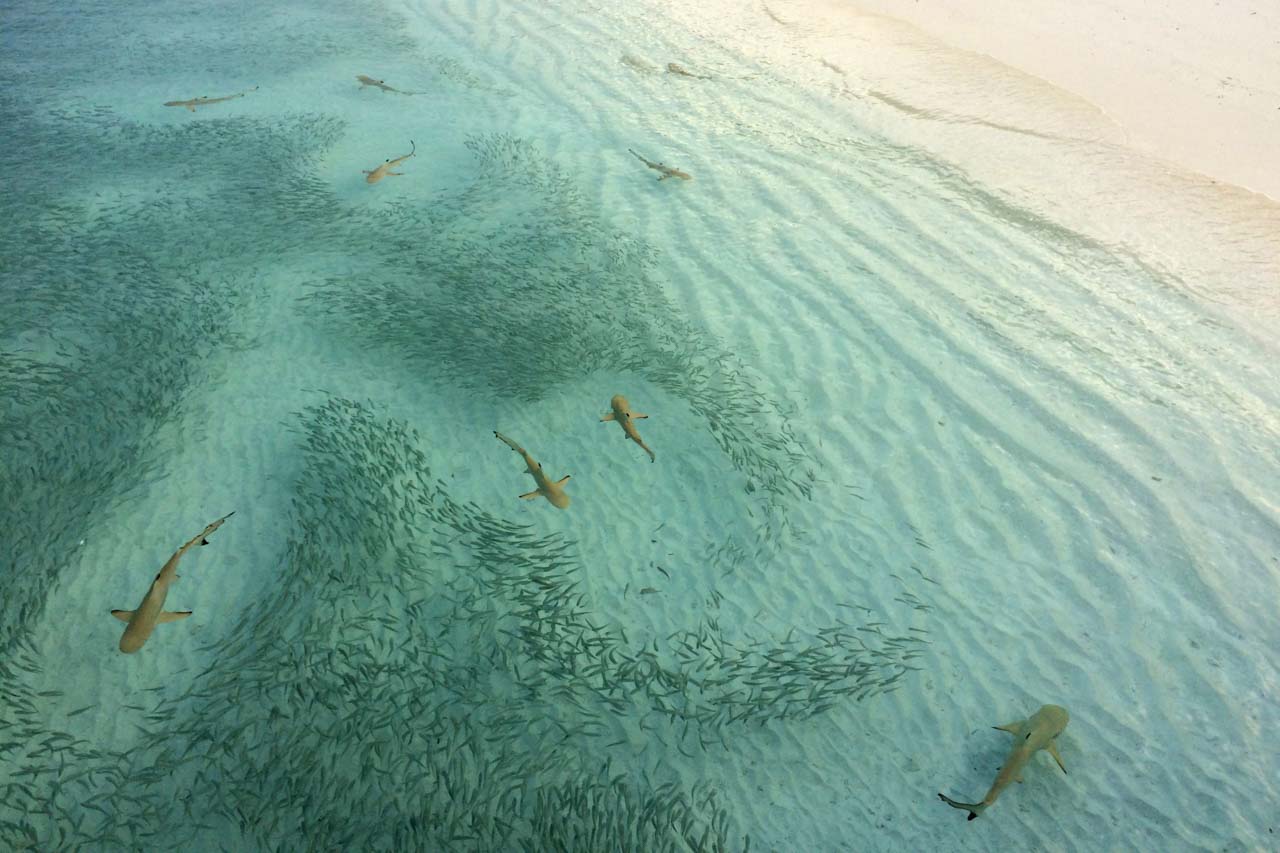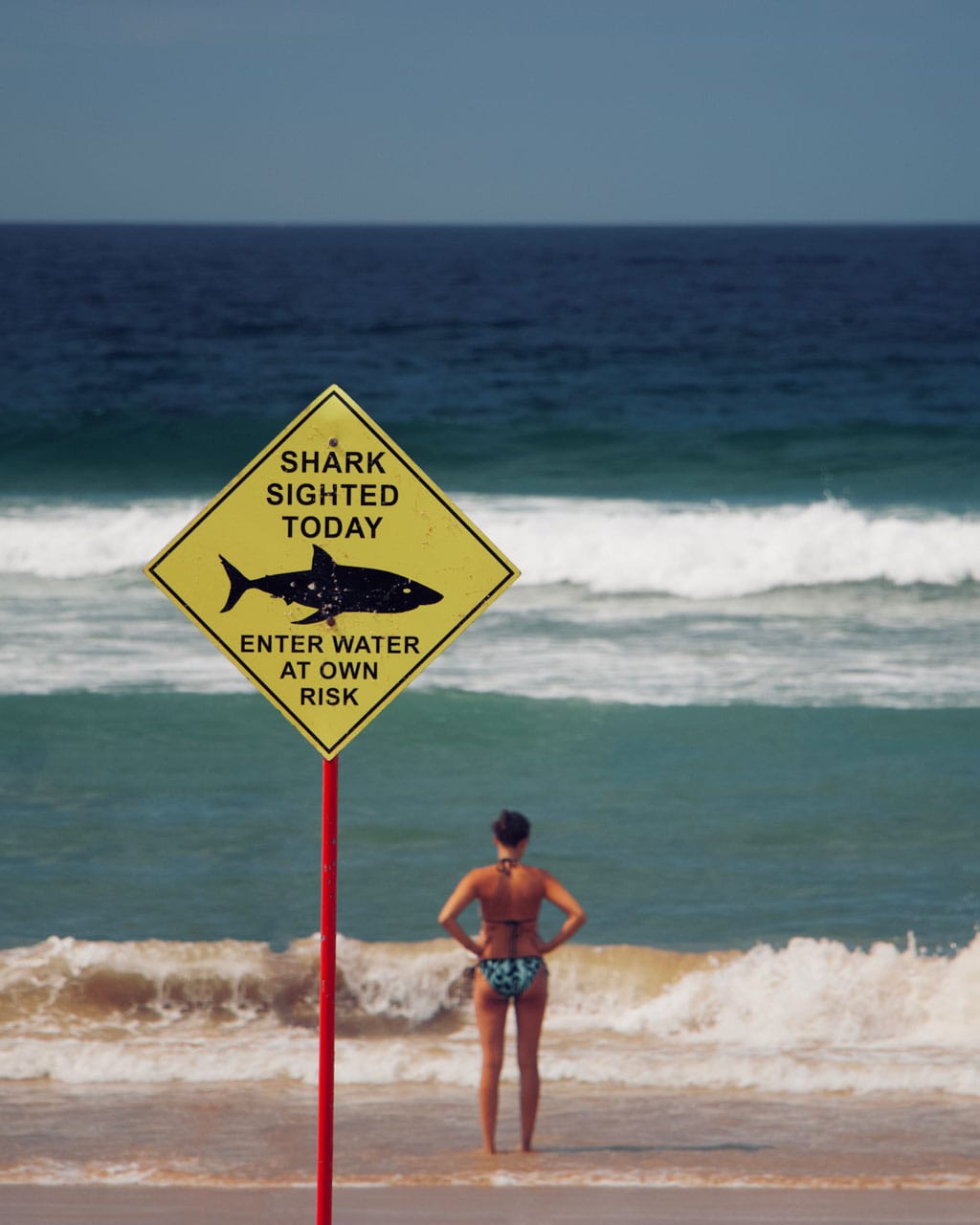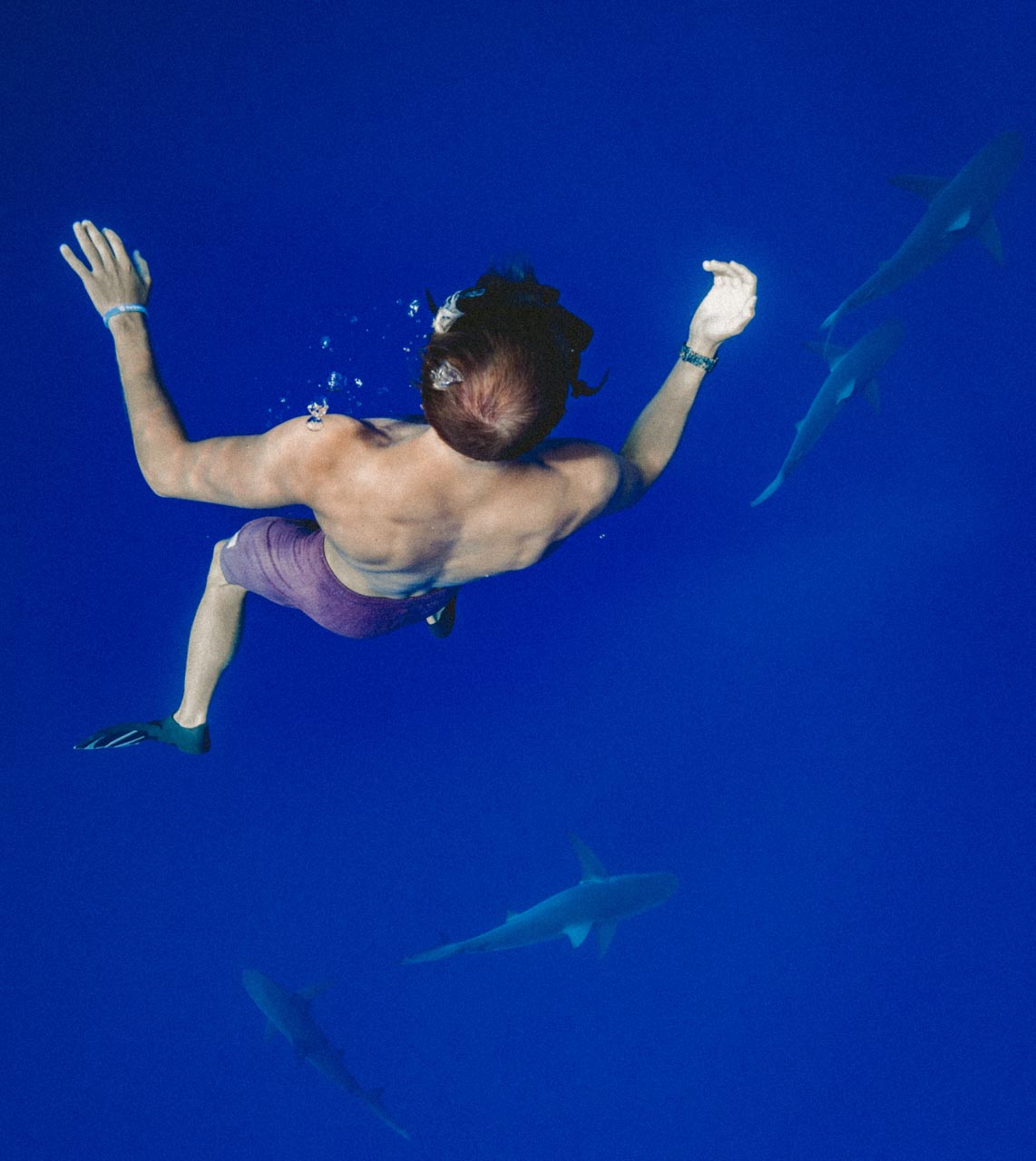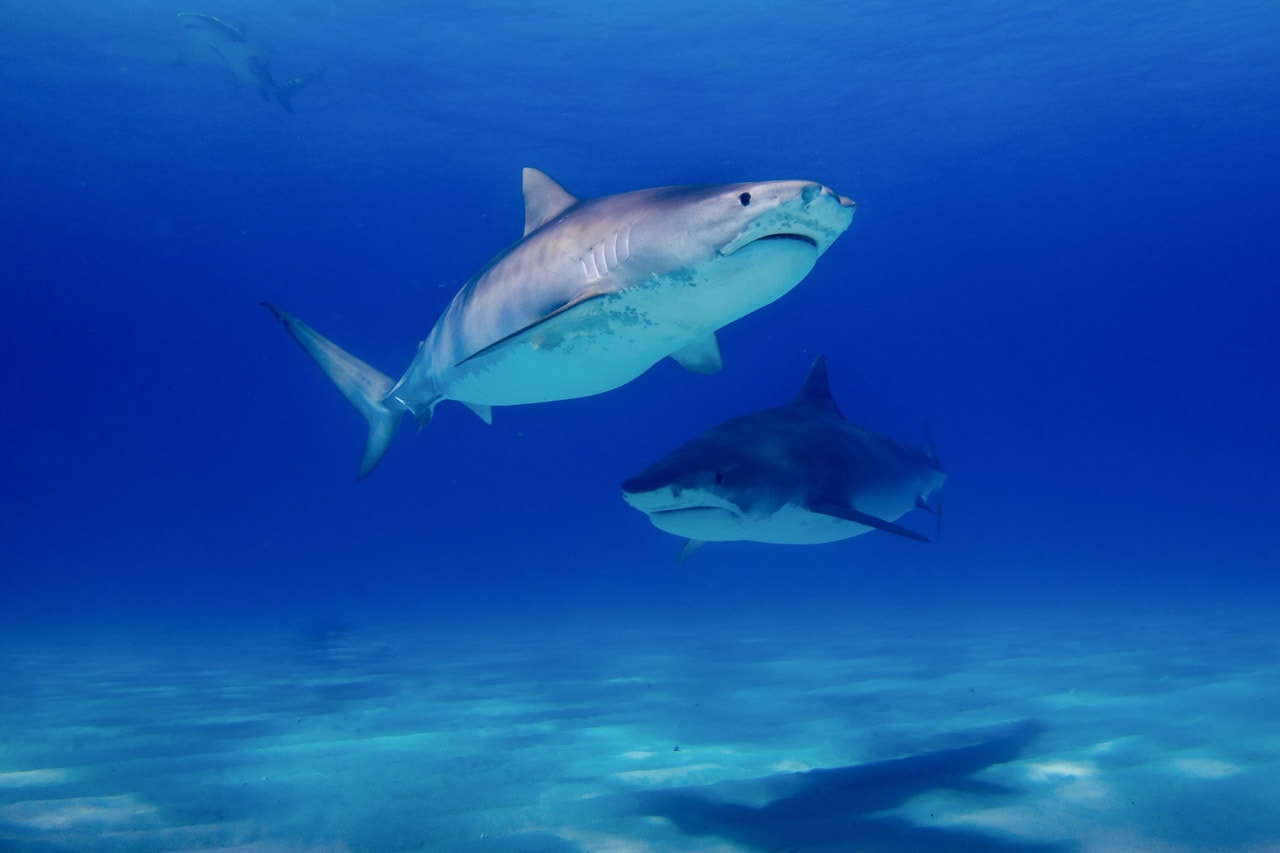This how to avoid shark attacks safety post contains affiliate links. You can read more about our Terms of Use / Disclosure here.
Easily the most feared marine creatures, sharks are also among the world’s most misunderstood animals.
Hollywood blockbusters like Jaws have not done sharks any favors, portraying them as vicious bloodthirsty predators. This reputation is not fair and really needs to be put into context.
Yes, sharks are apex predators. They’re at the top of the food chain, hunting other animals (and by doing so keeping populations in check). Humans, however, also eat other animals—and so do dogs, cats, bears and eagles.
Sharks hunting seals is as natural as bison eating grass.

These large fish are a natural presence in many seas and oceans, a critical part of regional ecosystems. As they go about their daily lives, shark attacks on humans do occasionally occur, though, but not all shark bites are necessarily predatory.
Sometimes, it’s nothing more than a way for a shark to protect its personal space, pretty similar to barking dogs and charging grizzly bears.
Either way, a shark attack is always a terrifying experience.
And no matter how low the risk may be—you’re more likely to die from a lightning strike, bee sting or rattlesnake bite—, there is a risk of getting attacked by a shark when swimming, snorkeling or scuba diving in shark territory.
In this post, I’ll explain in detail how to avoid shark attacks, what to do when you encounter a shark in the water, and how to fight off a shark.
Contents
Shark Attack Safety Tips: Precautions & What to Do During Encounters

How to Avoid Shark Attacks
First of all, when planning a water-based activity, it’s essential to inform yourself about the potential presence of sharks. Visit a local visitor center or tourist office and watch for posted warning signs.
Awareness is always the first step of prevention—and possibly survival in case of an actual shark attack. Always pay attention to your surroundings and the water conditions.
- Don’t swim too far from the shore. Even though sharks do come close to shore as well, the further away you are, the harder it will be for help to reach you.
- Don’t go into the water when bleeding, including from wounds, cuts and menstruation. Sharks are able to sense even the tiniest amount of blood from as far as a mile away.
- Stay in groups. Solo swimmers have a much higher chance of encountering or getting attacked by a shark.
- Take off all shiny objects and jewelry. Light reflected from such objects might resemble fish scales.
- Don’t wear bright swimwear. Sharks are very good at seeing contrast, especially in low-visibility water.
- Don’t go swimming at dawn, dusk or darkness. This is when sharks are most active.
- Avoid places where seals are present and schools of fish can be seen. These are preferred prey.
- Avoid fishing boats and areas with fish blood or fish bait. (Dead) fish attract sharks.
- Stay away from areas with lots of bird activity or large groups of dolphins. They eat the same food that sharks eat.
- Avoid places where sewage and waste enters the water. This attracts fish, which in turn attract sharks.
- Try not to splash a lot. Frantic movements like this draw the attention of sharks.
- Stay clear of murky waters, river mouths, channels, sandbars, entrances to harbors and steep underwater cliffs. Sharks like hanging out in these kinds of places.
All these tips are basic common sense. Don’t go swimming among prey, avoid the preferred hunting grounds of sharks, and stay out of the water at twilight or night.
You can avoid shark attacks by keeping these twelve tips in mind when visiting beaches or waters that may be home to sharks.

What to Do If You See a Shark While Swimming
Even if you are super-careful and follow all the above tips on how to avoid shark attacks, it’s still possible—although extremely unlikely—to accidentally encounter a shark in the water.
Stay calm
It’s important not to panic. I realize that’s much easier said than done, but it’s critical that you don’t start splashing.
The shark has most likely been aware of your presence for a long time before you noticed it yourself, and you don’t want to seem like an injured animal by frantically splashing.
Leave the area and leave the shark alone
Obviously, you should never swim toward a shark or try touch it. Don’t harass or provoke a shark, not even if it’s a small one. Small sharks have teeth, too. Swim back to shore as fast as you can, while staying calm and focused.
Get out of the water if you feel something touch you
Some victims of shark bites don’t immediately feel pain. If you feel something brush against you, get out of the water as fast as you can.

What to Do If a Shark Attacks You
If you have the misfortune of actually being the victim of a shark attack, there are still a few things you can do to increase your chances of survival.
Defend yourself in any way possible
If you see a shark attack coming, prepare to vigorously defend yourself.
Use whatever means and weapons you have. Only use your hands and feet if you have no other tools at your disposal.
Hitting the shark’s nose is only advised as a deterrent when the animals comes too close and inspects you, since that will put you really close to its mouth and teeth.
Instead, focus your blows at the shark’s gills or eyes, its most sensitive places.
Be as aggressive as you can
Playing dead is absolutely useless during shark attacks. Fight back with all your might.
Your best option of defense is clawing at the shark’s eyes and gills.
Leave the water as quickly as possible
In case you’re bitten, you have to try to stop the bleeding. Get to shore as fast as you can, but stay calm. A lot of sharks will not attack again after the first bite, but it’s better to be safe than sorry.
Get out of the water! It’s your only way of survival at that point.
Seek medical attention immediately
Whether you’ve sustained a tiny cut or horrible injury doesn’t matter. It’s absolutely vital that you get help from a medical professional ASAP.
Note: It’s also useful to know that there are different types of shark attacks. The Florida Museum explains the difference really well here.

Where to See Sharks in U.S. National Parks
Since this website is primarily about the U.S. national parks, it’s worth mentioning which parks are home to sharks.
The National Park System encompasses a number of coastal and island national parks and seashores.
Almost all of those are frequented by several different shark species, from the docile nurse sharks to the misunderstood great white sharks, more aggressive bull sharks and iconic hammerhead sharks.
Here are several National Park Service units where you can see these beautiful marine animals.
U.S. East Coast National Parks and Seashores
- Acadia National Park, Maine
- Assateague Island National Seashore, Maryland and Virginia
- Biscayne National Park, Florida
- Canaveral National Seashore, Florida
- Cape Cod National Seashore, Massachusetts
- Cape Hatteras National Seashore, North Carolina
- Cape Lookout National Seashore, North Carolina
- Fire Island National Seashore, New York
U.S. Gulf Coast National Parks and Seashores
- Dry Tortugas National Park, Florida
- Padre Island National Seashore, Texas
U.S. West Coast National Parks and Seashores
- Channel Islands National Park, California
- Olympic National Park, Washington
- Point Reyes National Seashore, California

Shark Encounters Safety FAQs
When Do Sharks Come Close to the Shore?
Many shark species tend to come closer to the shore at their preferred feeding times. This is typically at dawn and dusk and during the night.
One of the best tips on how to avoid shark attacks is to stay out of the water at those times.
Why Do Sharks Attack Humans?
There are a number of different reasons why sharks attack. Not all shark bites are predatory. Sometimes, sharks bite out of curiosity or as way to protect their personal space.
Additionally, many shark attacks are accidental and occur when the shark confuses a human for favorite prey species like seals and sea lions.
Other shark attack triggers include traces of blood in the water, whether or not from wounds, and frantic splashing movements.
When Do Sharks Attack?
There are two different types of shark attacks. The most avoidable type is the provoked shark attack. Those happen when a person approaches, touches, unhooks or releases a shark. They’re usually defensive in nature.
The second type of shark attack is the most dangerous—the unprovoked attack. This is when the first contact is made by the shark.
Unprovoked attacks are often very serious and occur when the shark is hunting.
However, most shark attacks are a mistake on the part of the shark, when it confuses a human for a much tastier and fattier prey like seals or sea lions. This typically occurs in low-visibility waters.
Sharks do not actively hunt humans. Yet, since unprovoked attacks are often predatory—whether or not by mistake—the resulting bite wounds can be severe.
What Attracts Sharks to Humans?
One of the first things to know about avoiding shark attacks and what actually draws sharks to humans. Avoid attracting sharks and you won’t get attacked.
- Shiny objects and jewelry
- Blood
- Brightly colored clothing (yellow, orange and red), uneven tans or tan lines
- Splashing

How Many People Are Killed By Sharks Every Year?
According to the International Shark Attack File, there were only 5 shark attack fatalities in 2018, one of which was in the U.S. The total number of global shark attacks in 2018 was 130.
This is an extremely low number, especially when considering the enormous number of people—many millions—who go swimming, snorkeling or diving in waters that are home to sharks each year.
Additionally, when taking into account the fact that no fewer than 20 to 30 million (!) sharks are killed by humans every year, it’s easy to see that the balance isn’t exactly tipped in favor of the sharks.
This really nuances the perception that sharks are creatures that should be feared.
What Are the Odds of Getting Killed in a Shark Attack?
You’re 10 times more likely do die in a fireworks accident than from a shark attack. The odds of getting killed by a shark during one’s lifetime are 1 in 3,748,067. They’re ridiculously, laughably low.
How Fast Can Sharks Swim?
Sharks usually slowly cruise through the water no faster than 1.5 miles per hour. Some sharks might casually swim as “fast” as 5 miles per hour. (Note: that’s approximately the speed of the fastest Olympic swimmers.)
However, since many sharks are predators, they’re capable of short sprints when hunting. A few maximum swimming speeds are:
- Great white shark: 25-35 miles per hour
- Blue shark: 25 miles per hour
- Hammerhead shark: 25 miles per hour
- Tiger shark: 20 miles per hour
- Whale shark: 6 miles per hour
What Is the Most Dangerous Shark?
Although any shark of 6 feet (2 meters) or more in length is potentially dangerous to people, there are three specific shark species that are responsible for most attacks on humans:
- Great white shark
- Tiger shark
- Bull shark
These three species live all over the world, grow pretty large and eat big marine animals like seals, sea lions, sea turtles and other fish.
